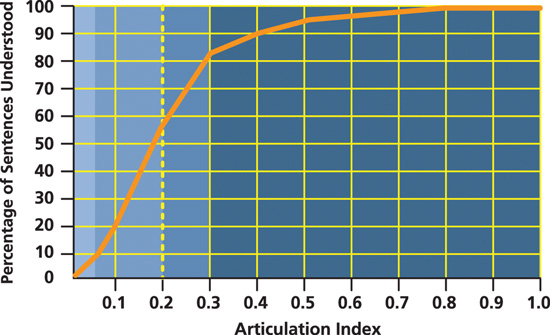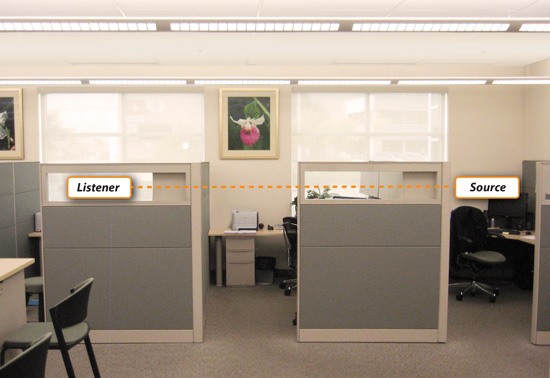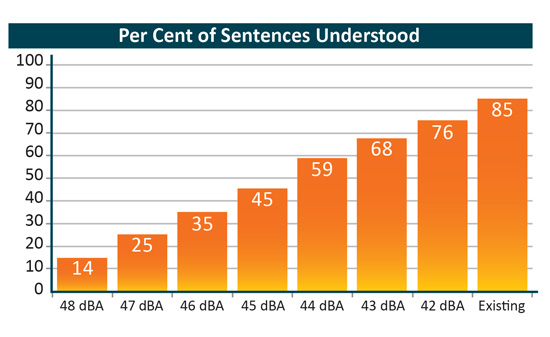Sound Masking 101
Measuring the Impact
Articulation Index (AI) tests conducted between two workstations illustrate the importance of keeping tolerance as low as possible and consistently meeting the specified sound masking curve throughout the facility.

Image courtesy of K.R. Moeller Associates Ltd.
The relationship between Articulation Index (AI) and intelligibility is not linear. For example, a value of 0.5 means a listener can understand approximately 95 percent of a conversation, not 50 percent. A very low AI value is required for true privacy.
To calculate AI, one uses a test signal that includes the frequencies known to specifically impact speech comprehension. This signal is measured at 1 meter from the ‘source’ and again at the ‘listener’ location. The background sound level is also measured at the ‘listener’ location in order to quantify how loud the test signal is relative to it—a value known as the signal-to-noise ratio (SNR). This value is critical, because the lower the SNR, the less the intelligibility and the greater the speech privacy. For AI, SNR is measured in each of 15 frequency ranges (from 200 to 5,000 Hz). Each of these ranges is weighted according to the degree to which it contributes to speech comprehension. The final AI value ranges from 0 (where conversation is completely unintelligible) to 1.0 (where everything is heard and understood).
In this case study, the occupants sit approximately 15.5 feet (4.7 meters) apart within an open plan (Figure 1). The partitions are 64 inches (1.6 meters) in height, and the ceiling tile is highly absorptive. However, without sound masking, the ambient level is only 40.6 dBA, and the listener can understand 85 percent of the other person’s conversation. When masking is applied, comprehension quickly declines. In fact, for each decibel of increase in masking volume, comprehension drops by an average of 10 percent (Figure 2). With the masking set to 48 dBA (i.e. the typical maximum level for comfort) with a narrow tolerance of ±0.5 dBA, the listener can understand just 14 to 25 percent. When a broader tolerance of ±2 dBA is applied, they can understand up to 59 percent—barely an improvement over the unmasked conditions.

Photo courtesy of K.R. Moeller Associates Ltd.
Figure 1: Articulation Index (AI) tests were conducted between these two workstations to illustrate the impact tuning tolerances have on sound masking’s ability to improve speech privacy and, hence, the importance of closely and consistently meeting the specified sound masking spectrum or curve throughout the facility.

Image courtesy of K.R. Moeller Associates Ltd.
Figure 2: Though a small amount of deviation is unavoidable, the Articulation Index tests show that too broad a tolerance (e.g. of ±2 dBA) represents more than a 40 percent drop in sound masking performance. A tight tolerance of ±0.5 dBA ensures the masking effect is consistently experienced across the space.
Though this example focuses solely on volume, variations in frequencies can similarly impact masking performance.
A lack of acoustic privacy carries real risk, particularly in facilities where there is a perceived need for it or an expectation on the part of its users. Examples that readily spring to mind include hospitals, bank branches, law offices, government, and military facilities. However, other types of spaces—such as commercial offices, call centers, and hotels, to name but a few—have privacy needs as well. The degree required typically depends on the type of activities the space hosts.
In some countries, protecting verbal communication within particular types of facilities is actually mandated by law. The Health Insurance Portability and Accountability Act (HIPAA) introduced by the U.S. Department of Health and Human Services in 1996 is a good example. It requires healthcare entities to take “reasonable safeguards” to ensure speech privacy during both in-person and telephone conversations with patients and between employees.
Acoustic privacy is also vital to employees’ overall satisfaction with their workplace. A decade-long survey of 65,000 people run by the Center for the Built Environment (CBE), University of California, Berkeley, found that lack of speech privacy is the number-one complaint in offices. Participants expressed irritation at being able to overhear in-person and telephone communications, as well as concern for their own level of privacy.

Image © iStockphoto.com/kupicoo
Studies show that employees spend the majority of their time on individual focus work. Speech privacy and noise control are vital to concentration and workplace satisfaction.
The topic of workplace satisfaction also emphasizes the need to consider those occupying spaces other than closed rooms. Though some may dismiss the importance of acoustic privacy when designing an open plan, studies show that it has a significant impact on productivity. For instance, research conducted by Finland’s Institute of Occupational Health shows that unwilling listeners demonstrate a five to 10 percent decline in performance when undertaking tasks such as reading, writing, and other forms of creative work. Simply hearing that someone is speaking can disturb concentration, but this problem is greatly magnified when you can clearly understand what they are saying because, if you can follow a conversation, it is much harder to ignore it.
Though an organization might not consider privacy a goal within an open plan, it is impossible to justify increasing disruptions. Taking the steps required to lower speech intelligibility within this type of space increases occupants’ output and reduces error rates.









